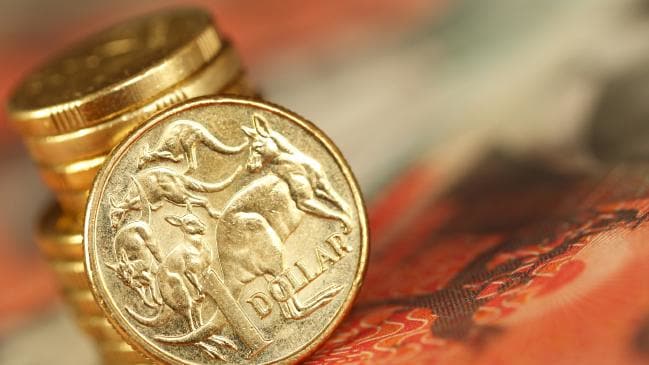
Aussie plunges again as RBA cuts forecasts
The RBA has dramatically revised down its economic forecasts amid the ongoing property market correction, prompting the Australian dollar to plunge again.
The Reserve Bank has revised down its economic forecasts as expected, but the Australian dollar has plunged again after the central bank surprised the market with the scale of its revisions.
Economists had long warned that the ongoing property market correction and sluggish consumer spending meant RBA growth forecasts were overly optimistic.
But the Aussie dollar, already down about 2.5 per cent this month against the US dollar, dropped another third of a US cent on Friday after the RBA substantially cut inflation and GDP forecasts for the year to June and the following 12 months.
“These were foreshadowed to an extent in the governor’s uncharacteristically dovish speech earlier in the week, but the magnitude is still probably a bit larger than one would have thought,” JPMorgan strategist Ben K Jarman said.
“It is hard to read this as anything less than a capitulation on the RBA’s long-held view that the economy is improving, and that the consumer can withstand headwinds from housing and wealth effects.”
RBA governor Philip Lowe admits the Aussie economy may be weaker than expected.Source:News Corp Australia
Governor Philip Lowe this week tempered his previously optimistic language when the RBA kept the cash rate at a record low 1.5 per cent for a 30th month, but dropped its longstanding prediction that an improving economy meant the next move was likely to be upwards.
The 30-day interbank cash rate futures suggests the market has priced in a near 100 per cent chance of a rate cut in the second half of 2019.
The RBA elaborated upon its new neutral stance in Friday’s Statement on Monetary Policy, saying it now expects economic growth of 2.5 per cent in the 12 months to June this year — down from its previous forecast of 3.25 per cent.
It similarly slashed its inflation forecast for the same period from 2.0 to 1.25 per cent.
Its annual GDP and inflation forecasts for the year to June 2020 were cut from 3.25 and 2.25 per cent to 2.75 and 2.0 per cent respectively.
The RBA cited slowing growth in other advanced economies, sluggish consumer spending and the ongoing property market correction.
“This reassessment of the outlook for consumption is informed by the downward revision in the national accounts and, to some extent, the recent declines in housing market activity,” the RBA said in the quarterly statement.
“The outlook for household consumption growth continues to be one of the key sources of uncertainty for the domestic growth forecasts, particularly given certainties around the outlook for income growth and how developments in housing markets will affect household decision-making.”
The Australian dollar, which was worth 72.95 US cents on January 31, slipped from 70.99 to as low as 70.61 within 45 minutes of the statement’s release.
Economists said the reserve bank would cut the cash rate twice before the end of the year, which they say would trigger the Aussie dollar to fall well below the 70 US cents mark.
MacroBusiness Fund chief strategist David Llewellyn-Smith criticised Dr Lowe, saying the RBA’s insistence the local economy was strong led the share market to take an artificially inflated view.
“The likelihood is that they will have to cut because house prices nearly always draw the broader economy into weakness, and they’re falling very fast in Sydney in Melbourne and are now falling in all major capitals.”
He said the Aussie dollar could be as weak as 65 US cents by the end of the year, while AMP Capital chief economist Shane Oliver said strong commodity prices would ensure it would weaken to dramatically.
Dr Oliver told news.com.au the expected US rate hike would compound the weakness of the Australian currency.
“If our interest rates have been falling below those in the US, then that just makes it less attractive to park your money in Australian dollars versus US dollars,” he said.
“And that will put more downwards pressure on the Aussie, pushing it into the 60s.”
Economist John Adams was more critical of Dr Lowe’s assessment of the landscape, labelling the governor’s renewed position a “complete misdiagnosis as to the state of the Australian economy”.
“The governor failed to acknowledge the severe economic and social challenges that Australia faces from the current domestic debt bubble, which is the largest in our nation’s history,” he said.
For more information refer:
https://www.news.com.au/finance/markets/australian-dollar/aussie-plunges-again-as-rba-cuts-forecasts/news-story/d710427caaeb2d3676607f9438f2bf54#itm=newscomau%7Cfinance%7Cright-now-in-%7C1%7CAustralian%20dollar%20plunges%20again%20as%20RBA%20cuts%20economic%20forecas…%7Cindex%7C%20finance&itmt=1549614880575

